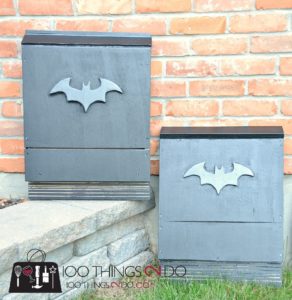Bat Box
Bats are underrated. Besides being the only mammal that flies, most North American bats are nocturnal insectivores, which means they feed on night-flying insects—especially mosquitoes. In fact, a small bat can devour more than 600 mosquitoes in a single hour. They also eat beetles, wasps, and moths. So encouraging bats to nest near your house is a natural way to keep your yard bug-free.
This bat house is easy to make in an afternoon. Its shallow construction is designed specifically to attract bats, which like cramped, dark spaces for nesting. Kids can do lots of the work involved in making this bat house, including measuring, driving screws, and painting. Parents need to help out with the sawing. Once you’ve finished it, hang your bat house high in a sunny corner of your backyard, and the bats will soon find a stylish new home.
Bats are very particular about where they’ll live, and their houses have to be constructed in a specific way that encourages them to nest. The inside of this house is painted black to keep it dark and warm, and the outside is a color that makes it blend in with the surroundings. The space where they go inside the house and roost is only about ¾ inch thick (with a small gap for air circulation). Still, dozens of bats will be able to live in this box and raise their pups.
When working on this project, keep safety in mind at all times. A jigsaw is better off in adult hands, but kids can help out by caulking, driving screws, attaching the netting, and painting. Make sure everyone has safety glasses on when the saw is in use, and keep sleeves away from power tools.
Using a tape measure and straightedge, mark up for cutting a 2-by-4-foot piece of ½-inch exterior-grade plywood: You’ll need one piece that’s 2 feet wide and 26 inches long and one that’s 2 feet wide and 22 inches long. Clamp the plywood to a worktable. Make sure you have on safety glasses, then use a jigsaw or a circular saw to cut the plywood.
To parents: Using a jigsaw is definitely a job for an adult. But take this opportunity to teach your kids saw safety so they’ll be ready when they’re old enough.
Print out the template for the bat cutout. Or create your own bat shape using circular and oblong templates called French curves (available at most office supply stores). Lay out the bat shape on the edge of the shorter piece of plywood—just make sure it’s 24 inches wide.
Hey, kids! French curves are great for helping you draw the bat wings, but you can also trace cans or cups to make curves of different sizes.
Clamp the plywood with the bat design to your worktable, making sure the whole bat hangs over the edge. Using a drill/driver with ¼-inch bit, drill holes just inside the points of the bat shape. This will make it easy to turn your jigsaw blade as you cut out the curved parts.
Using a jigsaw fitted with a narrow scroll blade, which is designed for making intricate curves, cut out the bat design. Cut the shape closest to the edge first, then cut the whole bat from the sheet. Because both halves of the cutline need to look clean, work slowly and carefully. Whenever you get to a drill hole at one of the points, stop the saw and turn it before you continue.
To raise the front panel off the back and create a small crawl space to house the bats, you’ll need strips of lumber around the edges. Cut three pieces from a 1×2: one 24-inch piece and two 19-inch pieces.
Using a caulk gun, lay a bead of caulk along the face of the long 1×2. Line it up with the top edge of the larger piece of plywood, and clamp it in place with spring clamps. Using a drill/driver, drive 1-inch deck screws through the 1×2 and into the plywood every 6 inches to hold it in place.
Attach the two shorter pieces to the sides in the same manner, and caulk the ends where they meet the top piece before you clamp them down. Use a damp rag to wipe up any caulk that oozes out.
Hey, kids! You can help out with the caulking while your parents get the clamps ready.
Using a brush and roller, paint the back piece black, from the top edge to the ends of the 1x2s. Also paint the back of the front piece black. These will form the dark inside of the bat house.
Paint the other surfaces in a color that will help maintain a healthy temperature inside the house. If you live in the North, a dark color can keep the house toasty by absorbing the sunlight. In the warm South, a light color may be a better choice. Be sure all surfaces of the wood are painted and well sealed.
Let the paint dry completely.
Unroll the deer netting, and lay it over the inside of the back section, flat against the plywood. Using a staple gun, attach the netting to the inner edge of the top 1×2 and along the sides. Make sure to pull it taut so that it can’t sag when bats hang from it. Extend the netting all the way over the bottom edge, and wrap it around to the back. Once it’s stapled all around, cut off the excess.
Caulk along the face of the 1x2s on the back section. Place the front piece onto the 1x2s, with the bat shape facing the bottom, and the top edges and corners lined up. Clamp it in place. Drive 1-inch screws every 6 inches through the face and into the 1x2s to secure it.
Caulk the exposed sections of the 1x2s, then place the cutout onto them, just below the large front piece. Leave a ½-inch gap between the two for the air vent. Clamp the piece, and attach it in place with a single 1-inch screw on each side.
Hang your bat house under the eaves of your house or from a tall, flat pole made from pressure-treated lumber. (Make sure to bury one-third of the lumber in the ground to keep it steady.) Attach it by driving 3½-inch deck screws through the corners into the siding or fascia of your house or, if you’re using a pole, along the middle at the top and bottom.
The bat house should be at least 15 feet off the ground, away from bright lights. Choose a place that faces south so that it gets plenty of sunlight (aim for 6 to 10 hours of exposure). This will keep it nice and hot—just the way bats like it!
To parents: Hanging the bat house is a job best left for adults. Just be sure to practice when you put it up.
The original plan can be found at https://www.thisoldhouse.com/how-to/fun-family-project-how-to-build-bat-house
























